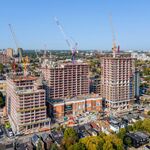drum118
Superstar
I am in London at this time and all the bus stops have vending machines. You put your money into them and will be given a card to show the driver that you paid your fare. We have a 6 zone card for the week that allows us use to buses, rail, tube and trams in those zones. The machine is like a paper box, but thinner.
I am wait to see what is plan for TTC as there will be always riders paying cash to use transit, as well cost.
If London "Can" have vending machines at all stops, no reason reason TTC cannot just like VIVA has done. VIVA is over kill.
In the train stations, machines are built into the wall or are stand alone to buy a card to be used getting threw the gates at both end of your trip.There is staff at the gate to help you if you have problems with the card. This also applies to the tube system and will get a video showing how easy to use it.
Up in Glasgow and Edinburgh, its the same thing. On the buses, driver accept cash fare and issue you either a daypass or a transfer.
Viewing the new Edinburgh LRT line, its is a true LRT line as the stops are more than a mile apart outside the city core and and a but 3/4 of a mile in the city core in the centre of the road.
Due to a major landslide and flooding on both side of Newcastle, my train had to return to Edinburgh 2 hours after I left. The other haft had to get herself from the airport to the hotel the following day at 7am, as I was leaving on an 6 hour train ride with over 200 standees.
That night I ended up talking to a person in charge of the nighttime work and he confirm my suspicion that 4 blocks of the new tram tracks were going to open on Friday for the city centre area, but more like the weekend. 2014 is when the first tram will run, even though the fleet is sitting at the new carhouse out by the airport.
We are getting LRT equipment, but the system will be a streetcar/tram system unless stops are remove. Even then, the system will not be a true LRT system. St Clair would be an light LRT line due to traffic lights issues. Eglinton would be a more true LRT in the centre area, but still an light LRT elsewhere.
My view at this time.
I am wait to see what is plan for TTC as there will be always riders paying cash to use transit, as well cost.
If London "Can" have vending machines at all stops, no reason reason TTC cannot just like VIVA has done. VIVA is over kill.
In the train stations, machines are built into the wall or are stand alone to buy a card to be used getting threw the gates at both end of your trip.There is staff at the gate to help you if you have problems with the card. This also applies to the tube system and will get a video showing how easy to use it.
Up in Glasgow and Edinburgh, its the same thing. On the buses, driver accept cash fare and issue you either a daypass or a transfer.
Viewing the new Edinburgh LRT line, its is a true LRT line as the stops are more than a mile apart outside the city core and and a but 3/4 of a mile in the city core in the centre of the road.
Due to a major landslide and flooding on both side of Newcastle, my train had to return to Edinburgh 2 hours after I left. The other haft had to get herself from the airport to the hotel the following day at 7am, as I was leaving on an 6 hour train ride with over 200 standees.
That night I ended up talking to a person in charge of the nighttime work and he confirm my suspicion that 4 blocks of the new tram tracks were going to open on Friday for the city centre area, but more like the weekend. 2014 is when the first tram will run, even though the fleet is sitting at the new carhouse out by the airport.
We are getting LRT equipment, but the system will be a streetcar/tram system unless stops are remove. Even then, the system will not be a true LRT system. St Clair would be an light LRT line due to traffic lights issues. Eglinton would be a more true LRT in the centre area, but still an light LRT elsewhere.
My view at this time.






